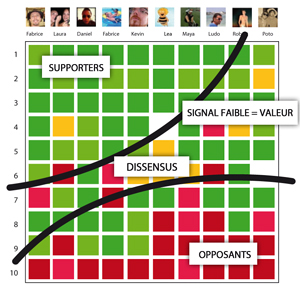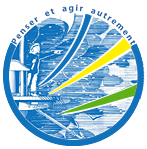The Color Insight: A Futuring Tool Based on the Régnier Abacus Principle
The abacus investigative method (Régnier Abacus®) uses experts' views expressed through color-coded votes and followed by debate on topics of common interest. This key tool is increasingly employed to consult specialists and stakeholders in forecasting sessions (of French studies: Santé 2025, Alimentation et société 2025).
The Entrepreneurs of the Future Circle in conjunction with the Fondation Prospective et Innovation and the Cne-Cnam (Conservatoire national des arts et métiers) financed the development of this software, a tool that was sorely lacking even at the international level in today's age of virtual networks and expert polls.
As a result, an innovative version of the abacus method accessible to the public at large is now available on line at www.colorinsight.fr.
This accessible computerized tool enables all potential users to apply the abacus method employed in futures consultations. Indeed, the Color Insight enables users to update futures studies, even on-line (topics, reminders, selecting experts, following up on answers, highlighting results…) and now all this through social networks or smartphones.

Download documentation

From Régnier to Color Insight
François Régnier came up with his patented abacus in 1973, while leading sessions on case studies with researchers and futures groups within the medical sector. He realized some ideas with high value added were simply not expressed during meetings. His solution was the abacus principle so that group representations on a particular subject could be teased out, discussed and debated using a colored voting system. The result is similar to a traffic-light reaction to statements like “health education is for specialists only”.
The Régnier Abacus method, a consultative technique for experts and actors that uses intuitive judgment, is ideally suited to gathering and processing qualitative data.
Nowadays, we have powerful engines to gather and process quantitative information, notably financial and economic number-crunching, but not much when it comes to qualitative information such as representations or the reasonableness of hypotheses. This type of information actually forms a significant part of the basis of strategic studies and foresight work. The Color Insight really proves useful in detecting weak signals, for, as we all know, what is a minority opinion today may become an obvious answer tomorrow.
Objectives
UNDERSTAND. Identify and understand the representations and analyses of one or several groups of experts and actors on subjects of mutual interest. Contrast representations of the future across various groups of actors on the same subjects.
LEAD AND SHARE . Lead a debate, meeting, training session or forum while allowing all participants to take a stand, express themselves, give their opinion and discuss an issue based on one statement, hypothesis or analysis proposed to the group.
TEST . Test, confirm the key components of an analysis in foresight or strategic studies using a broad base of experts or stakeholders (actors for change) after carrying out an exploratory futures exercise, after gathering data, but before building any scenarios or making any strategic proposals.
Description of the Method
The Color Insight enables group leaders or consultants to present a series of items (statements, hypotheses, key messages) to a group of people ranging in size from fewer than 10 people (restricted group) to several thousand (a form of survey).
The goal is to gather opinions from experts and actors, who react individually to each statement according to a color spectrum which translates the scale of possible opinions from very much in favor (green) to very much against (red). White symbolizes the inability to give an answer. After all, it is rare to find people with expertise in all areas.
Individuals may also decide to not reply, in which case the color attached to the answer is black. The results are gathered and presented in a grid which reveals the 'geography' of the group
The Colored Logic of the Régnier Abacus
• Green: I agree completely
• Light Green: I tend to agree
• Orange: I have mixed views.
• Light Red: I tend to not agree
• Red: I do not agree at all
• White: I do not know what to answer.
• Black : I do not wish to answer.
It is possible to generate a '3-D problem card' by extending the procedure to one or more groups and covering a set of messages about a specific subject. There are lines (messages or items) and columns (experts) which intersect and show the seven choices on a decision-making scale: 5 colored choices, black and white (the position of the participant p on item i).
Information Processing
Unlike numerical charts, the Color Insight presentation enables users to perceive information wholly and immediately while respecting the individual, whose view is not diluted in a statistical average. The principle of the Régnier Abacus is reflected in the color-coded scale used in the chart which has a horizontal column for the subjects voted on and a vertical answer column for each expert on those subjects.
This color-based chart is easily managed. It can serve as a historiogram for each question, votes may be ordered and categorized per question or expert and a hierarchical sort carried out. All of these help tease out the meaningful details. Consensus and dissension become visible right away.
Of course, the quality of an answer depends on the quality of the statement. To paraphrase Dr. François Régnier, the color-code summary yielded by the Abacus accelerates the communication process but does not erase the need to invest in a careful analysis of the vocabulary used to express the problem beforehand.
Color Insight: Functional Contributions
Different tools relevant to the Abacus method of expressing opinions through color-coded votes have been created. They now take advantage of the new possibilities offered by computers and electronic voting systems, portable or traditional.
Interest in the Abacus has never waned over the years; in fact, this tool may be found around the world, be it in the form of wooden cubes, magnets or software programs. The Color Insight tool, available in Cloud, thus accessible from any Internet browser makes the following major contributions:
• Participants may express themselves from any mobile phone or traditional computer (even for shared uses in a conference room, the telephone replaces 'ballot boxes' and any related devices).
• The Color Insight draws upon the strength of social networks to organize very broad consultations at a low cost.
• The method remains equally powerful when used from a distance or in a room with participants physically present.
Overall, the Color Insight allows you to create a perception study quickly and inexpensively.
The possibility of publishing results on social networks makes it possible to extend the exchange of opinions internally on a company's intranet. Where smartphone and internet use remain limited, the target audience needs to know how to use Web 2.0. Of course, the tool may also be used effectively with an e-invitation or paper invitation.
